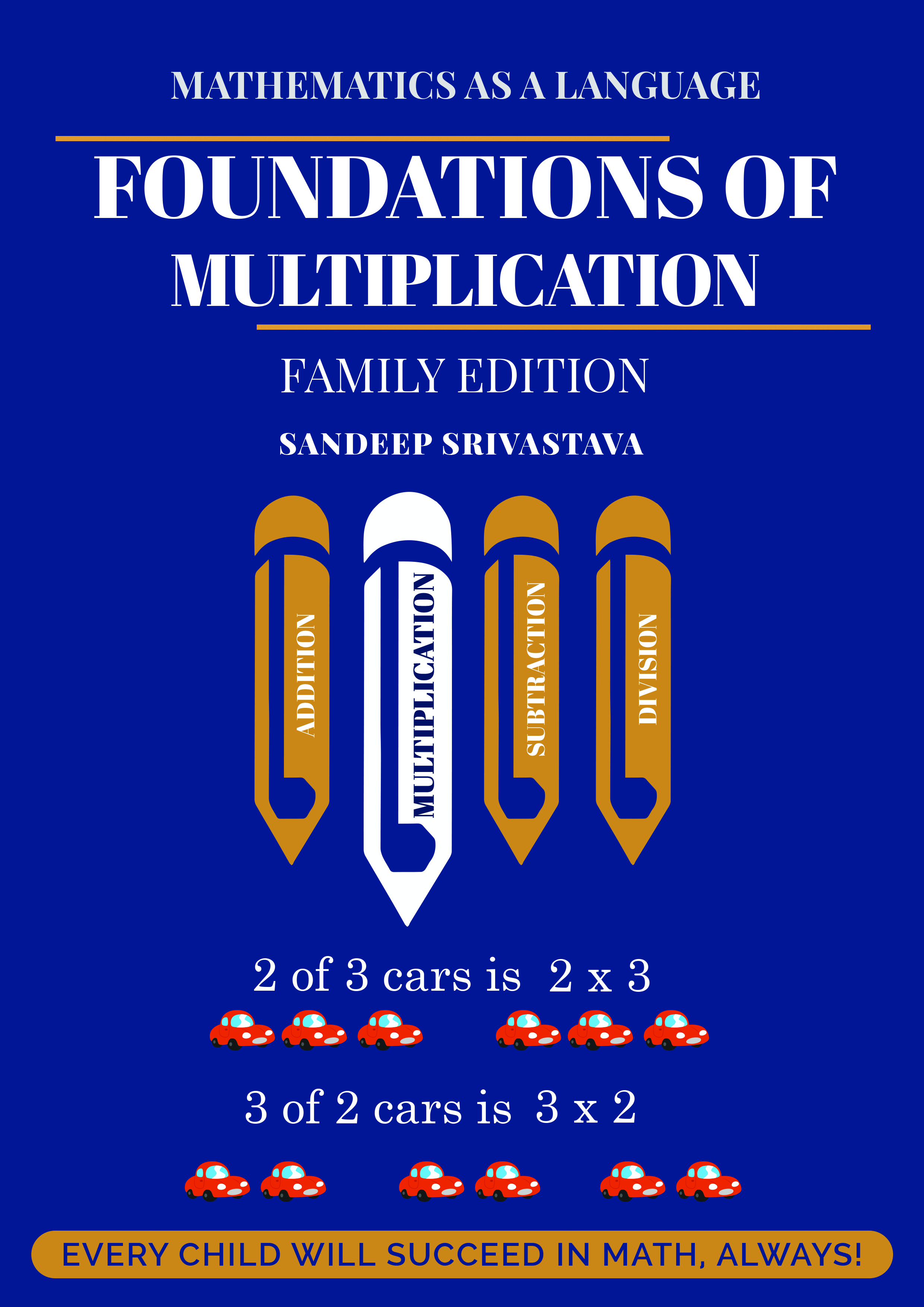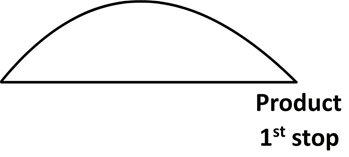
Foundations of Multiplication
This book is the second of the series of four books on 'Foundations of operations', the first was 'Foundations of addition'. It is part of the larger, revolutionary 'mathematics as a language' series. It is also pathbreaking for another reason - it is what we call 'family edition' of curricular math books - books meant for parents, for home.
A book on multiplication following addition is in itself a significant shift from the conventional and popular order of studying subtraction after being introduced to addition. Subtraction is the most complex of the four operations - needs more logical and linguistic maturity to appreciate and understand.
On the other hand, multiplication has a unique distinction among the four operations - it is the first, and the simplest derived mathematical operation. Thus, the significance of learning and mastering multiplication is far greater. It leads to quicker maturity of mathematical thinking and introduces the idea of relationship among operations.
The book offers unique insights into the nature of multipliers, multiplicands, and products (and factors too). In turn, the organic connection between math, multiplication and everyday living and work is very evident and hardwired in the brain.
No less importantly, the book is a text, nearly 250 pages, on logical thinking and reasoning entirely set in everyday life. In a way, the knowledge of multiplication is secondary. Every sentence of the book leads to another on the back of logic and reasoning. The book may be the most contextual text on logical development.
Excerpts from the book -
"It may just be added that multiplication in school math is introduced and reduced to a version of a nameless method, to find the product of two given numerals. As a result, ‘3 x 4’ and ‘3 x 2 x 2’, for instance, are exactly the same expressions, ‘equal to 12’. Not only is this meaning of the two expressions, being reduced to just 12, is highly myopic, it robs us of the diverse meanings and applications of multiplication.
To cite another example, the profound significance of a four-numbered multiplication expression, such as ‘1 x 2 x 3 x 4’, isn’t even obliquely referred to in school math books; not to talk of the incongruity of the expressions ‘1 x 2 x 3 x 4’ and ‘4 x 3 x 2 x 1’, and the need to defend the same."
Another revolutionary feature of the foundation series books is that there is no math-textbook-like exercise. The book is so rooted in real-world situations and events that each family can create hundreds of their own exercises (and need not look for correct answers). Parents don’t need any written exercise – our daily life and work is full of math situations and solutions.
1 + 1 is 11
Indeed, the only feasible and fail-safe way to enable parents to ensure quality education of their children is to empower every parent in their children's math education. 'Mathematics as a language' is just that math, no parents will be left behind!
Fortunately, there is more to it – math education (in schools) will not transform unless parents make a more critical contribution and play the primary role. Schools have a secondary role in rewriting math education just as they have a secondary role in ensuring high literary competence in the language of academics, and competitive levels in art, music, theatre, sports, etc.
Math–empowered parent is the (human) developmental salvation.
Some other highlights of the book
Due details on four interpretations of multiplication - Multiple addition of the same number, Expressing multi-dimensionality, Scaling/stretching, Being the operation to express the parts of a number – factors
Most comprehensive visualisation of every aspect of multiplication
The Long Multiplication method is logically discovered - a first for a curricular math book
The only math learning resource for young adults and professionals across the spectrum to start building the foundations for linear algebra (and Big data).
Operational relationship of addition and multiplication.
We already know good bits about the conceptual relationship of addition and multiplication. Let us now interpret the relationship in terms of the practice of addition and multiplication. Here is a listing of 10 operational relationships between addition and multiplication with examples of each relationship.
- The sum of multiple same number can also be obtained as the product of two numbers (A of B); 4 people + 4 people + 4 people is the same as ‘3 of 4 people’
4 + 4 + 4 - The two numbers are – count of the multiple additions (A), and the number being added multiple times (B); in the above example, A is 3 and B is 4 people.
Multiplication is encoding addition expression in a way that is shorter. The DNA of the addition in encoding is in the multiplicand.
A is the multiplier, and B is the multiplicand; the quantity is represented by B – 4 people. - The sum and the product have the same unit; the unit is the same as the unit of counting that produced the number being added – ‘12 people’ is the sum and ‘12 people’ is the product, and 3 groups of people were counted.
The product is some multiple counts of the multiplicand, thus, it has the same unit as the multiplicand. - Addition and multiplication are reversible expressions. Addition of a kind can be expressed as multiplication and vice-versa. For example 5 + 5 + 5 = 3 x 5 and 3 x 5 = 5 + 5+ 5; 9 + 9 + 9 + 9 + 9 = 5 x 9 and 5 x 9 = 9 + 9 + 9 + 9 + 9. This relationship is at the heart of conversion of mixed addition and multiplication expressions.
- A mathematical expression can have addition and multiplication operation; 6 people + 3 x 4 people (e.g., 6 singles and 3 families of 4 people each). This is one of the more important characteristics of the operational relationship of addition and multiplication. 6 + 3 x 4 is 6 + 4 + 4 + 4. It must be seen as key evidence of the reversibility of addition and multiplication.
- We will have to first find the product of all multiplication expressions in given mixed expression. For example, in 6 + 3 x 4 we will first find the product of 3 x 4 and then add that to 6. This relationship is critical operationally. In the expression 6 + 3 x 4, 6 + 3 x 4 cannot be added – they are not like expression. And 3 x 4 is anyway an addition expression and thus it is 6 + 4 + 4 + 4, or 6 + 12.
- Just as addition is faster (and less error-prone) counting, multiplication is faster addition (and has lesser errors than addition). We will see evidence of these assertions when we discover the method of multiplication.
- Addition and multiplication are mathematical ways of expressing the quantitative aspects of everyday, ordinary actions that are part of our lives. We are adding things when we are buying something, paying cash somewhere (by adding different currency denominations to arrive at the money to be paid), totaling the students in a school bus, and many others.
- We are multiplying things when we are selling or buying things in groups such as in dozen, kg, litre, packets, etc. When we finding out the distance, we will travel in a given time period and at a given speed, we use multiplication again.
Now, let us see how the multiplication actions the addition of a term. Evaluate the action of finding distance travelled in a specific time, at a given speed. Assume the given time to be three hours and the speed of jogging be 6 km per hour. We will graphically see how multiplication and addition are related. - It is for more common to have both operations in many expressions, for example:
- In calculating the height of a wall which has bricks of two sizes (especially, different heights)
- Finding the total amount of money out of currency notes of different denominations.
- When a teacher has to find the sum of marks of 30 students (out of a test with maximum marks of 20)
- When we have to find the seating capacity of vehicles of different sizes. For example, 2 cars, 3 SUVS, and 2 motorbikes.
- When we have to find the total numbers of people living in an apartment building, we will find that the family sizes are repeating. For example, family sizes 2, 3, 4 are expected to be common.


Clearly, product is must faster to obtain.
